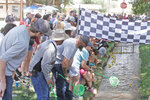Wind: mph,
Welcome to our new web site!
To give our readers a chance to experience all that our new website has to offer, we have made all content freely avaiable, through October 1, 2018.
During this time, print and digital subscribers will not need to log in to view our stories or e-editions.




The Tularosa Arts and History Council (TAHC) is hosting the second annual Rubber Duck Race on Saturday, June 8. Races and festivities will all be centered around the heart of Tularosa’s historic district at the corner of Encino and 2nd Streets, from 11 a.m. to 4 p.m. The event includes music, food trucks, games for kids and adults, giveaways, demonstrations and art and craft vendors. There will also be educational information on water preservation and how the acequia system works in Tularosa.
The rubber duck races take place on the acequia madre along Encino Road, between First and Third streets. The races will start with several heats, each with cash prizes. The final race, “The Big Quack” will include up to 700 rubber ducks. Anyone can adopt a numbered duck for $5 or $25 for a “six quack.” The first heat race starts at 11:30 p.m. and they will run approximately every half hour from there.
Proceeds from the event benefit the mission of the Tularosa Arts and History Council and help to further educate the local community on the history and preservation of the treasured acequia system throughout the village of Tularosa and surrounding agricultural farmers who are actively working their lands.
Tularosa gets its name from the Spanish description for the red or rose-colored reeds growing along the banks of the Rio Tularosa. The Rio Tularosa, which still exists along the north side of the village, attracted the original settlers as a water source in the desert. In 1863, the village of Tularosa was formally established and was mapped with 49 blocks and water rights distributed and recorded.
The original acequia (open ditch irrigation system) remains virtually unchanged and provides the water for the trees lining the streets, private gardens and landscaping within the original 49 blocks that give Tularosa its unique character.
In addition to the properties located in the historic 49 blocks, the original township of Tularosa, farmers and ranchers who have water rights use the water from the acequia as well.
Agricultural resources made possible by the system include several types of hay and other feeds for the livestock, as well as apples, plums, apricots, pomegranates, nectarines, figs, pecans, melons, corn, chile and many more fresh vegetables. At one time Tularosa also grew so much cotton that a cotton gin was built to be able to process and ship it. Livestock is also plentiful with cattle, sheep, pigs, goats and chickens.
With 27 miles of ditches, this open irrigation ditch system is one of the largest acequia systems in New Mexico with its inception in 1870 preceding the finalization of statehood for NM. This event is designed to create opportunities for all community members to learn more about how precious this historical water system is and what they can do to protect it – all while having fun with friends and family.
In 1979, the Tularosa Original Townsite District, consisting of the original 49 blocks on 1,400 acres (5.7 km2) including 182 buildings, was declared a historic district and recorded in the National Register of Historic Places.
The mission of the Tularosa Arts and History Council is to increase awareness of the talented artists, rich history and unique culture in and around the Village of Tularosa.
For more information on attending, sponsoring or being a vendor go to www.trytularosa.org or call Michael Gruger at 505-350-4531.